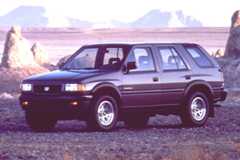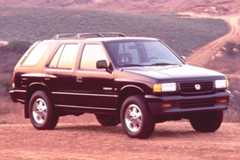| Midsize SUV; Built in USA |
|
|
| Good condition price range: $1,100 – $2,800* |

1995 Honda Passport LX 4WD

1995.5 Honda Passport EX

1996 Honda Passport LX

1994 Honda Passport DX

1997 Honda Passport
| Pros: |
|
| Cons: |
|
Though not lacking in features or capabilities, neither the Passport nor its Rodeo near-duplicate is quite in the league of a Chevrolet S10 Blazer or Ford Explorer.
Overview
Instead of creating a sport utility from scratch, Honda chose to market a near twin of the Isuzu Rodeo. Both are 4-door wagons with a lift-up rear window and fold-down tailgate.The entry-level DX had a 2.6-liter 4-cylinder engine, 2-wheel drive, and 5-speed manual shift. Stepping up a notch, the Passport LX used a 175-horsepower 3.2-liter V6, with 2- or 4-wheel drive and 5-speed manual or 4-speed automatic transmission. Topping the line was the EX, a 4WD V6 model with automatic. Rear antilock brakes work only in 2-wheel drive, and 4WD models have a part-time drive system (not for use on dry pavement).
Yearly Updates
| 1995 Passport Passports were essentially unchanged in their second season, except for extra equipment in the top-of-the-line EX model. However, dashboards were reworked in midseason, adding airbags for both the driver and passenger. |
| 1996 Passport Shift-on-the-fly for the 4-wheel-drive system arrived during 1996, and the V6 engine was enhanced to 190 horsepower. Four-wheel antilock braking was available, but only on the 4WD EX model. |
| 1997 Passport The entry-level DX model with its 4-cylinder engine disappeared, so all Passports now carried a V6 engine. |
Engines
longitudinal front-engine/rear- or 4-wheel drive
Until 1997, Passports were available with either a 4-cylinder engine or a V6. All models except the DX got the 3.2-liter V6, however, which began at 175 horsepower and jumped to 190 in 1996. Only 5-speed manual shift was available with the 4-cylinder engine, but other Passports might have an optional 4-speed automatic transmission instead. Honda’s 4-wheel-drive system is not recommended for use on dry pavement.
| ohc I4 | ||
| Engine Size (liters/cubic inches) | 2.6/156 | |
| Engine HP | 120 | |
| Engine Torque (lb-ft) | 150 | |
| Avail. Trans. | EPA MPG (city/hwy) | MPG avg. as tested |
| 5-speed manual | 18/22 | |
| ohc V6 | ||
| Engine Size (liters/cubic inches) | 3.2/193 | |
| Engine HP | 175-190 | |
| Engine Torque (lb-ft) | 188 | |
| Avail. Trans. | EPA MPG (city/hwy) | MPG avg. as tested |
| 5-speed manual 4-speed automatic | 16/19 15/18 | 14.6 |
Road Test
The V6 engine is smoother and quieter, and delivers stronger acceleration than the four. Though lacking the low-speed muscle of 6-cylinder engines in rivals from Jeep, Ford, and General Motors, the V6 furnishes sufficient go-power, even with an automatic transmission. Gas mileage is less pleasing. We averaged just 14.6 mpg with a V6 and automatic, with about one-third of the driving on expressways. Engine noise is moderate, but road and wind noise can interfere with conversations.
A Passport is tough enough for off-roading, but the ride gets stiff and bouncy over ruts and potholes, failing to absorb bumps well. Steering is tight, with good feel–easy to correct to stay on course in gusty winds, and delivering more positive control during off-road treks.
Head/leg room are plentiful, but rear entry is tight through narrow doors. Climbing aboard also demands a rather high step-up. The rear seat folds flat to create a wide cargo floor, but a full-size spare tire eats into space. Initial models had overly complex multibutton controls for lighting and wipers. Also, the radio sat too low for easy adjustments while driving. The new dashboard added in mid-1995 has a more convenient control layout. All models have plenty of handy bins and storage pockets.
Model Tested: 1996 Honda Passport 3.2-liter
Ratings values are on a 1-10 scale, with 10 being the best. With the exception of Value, these numbers reflect how the vehicle compares against the universe of vehicles, not just against rivals in its class.
Performance
Accommodations
Other
Total: 39
Specifications
| 4-door wagon | ||||||||||||||||||||||||
| Wheelbase (in.) | Length (in.) | Width (in.) | Height (in.) | Weight (lbs) | ||||||||||||||||||||
| 108.7 | 176.5 | 66.5 | 66.5 | |||||||||||||||||||||
| ||||||||||||||||||||||||
Model Tested: 1997 Passport 4-door wagon
NHTSA
(5 is the highest rating)
Front Impact Test
Side Impact Test
HLDI
(A score of 100 is average. Lower is better)
| Collision | 118 |
| Injury | 116 |
| Theft | 179 |
Trouble Spots
| Dashboard lights Description: The speedometer gear (in the transmission) seizes and gets stripped. (1994-96) |
| Hard starting Description: Engine may be hard to start after sitting due to fuel-injection leak-down requiring replacement of injectors. (1994-95) |
| Oil leak Description: Leaks at the spark-plug tubes allow oil to leak onto spark plugs. (1994-96) |
| Seatbelts/safety Description: Seatbelts may not retract or may retract slowly. Also, the button that keeps the seatbelt tongue from sliding down breaks. The belts should be serviced under the Honda Lifetime Seat Belt Limited Warranty. (1994-97) |
Recall History
| 1994 Description: Camshaft-seal end plug can become dislodged from cylinder head, allowing oil to leak; can cause engine damage and fire. |
| 1994 Description: Latch in seatbelt buckle could engage only partially, causing tongue to come out during collision or hard braking. |
| 1994-95 Description: Improperly-manufactured integrated circuit within voltage regulator can cause excessive electrical charging, possibly resulting in eventual engine stalling. |
Click on year to see equipment lists for all models offered for that model year.
Equipment Lists
Equipment lists are only viewable on larger screen sizes.
Pricing
Used-car pricing varies widely depending on local market conditions. Therefore, we recommend visiting websites that list used cars for sale to get a better idea of what a specific model is selling for in your area.
